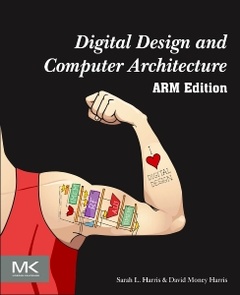Digital Design and Computer Architecture, ARM Edition ARM Edition
Auteurs : Harris Sarah, Harris David

Digital Design and Computer Architecture: ARM Edition covers the fundamentals of digital logic design and reinforces logic concepts through the design of an ARM microprocessor. Combining an engaging and humorous writing style with an updated and hands-on approach to digital design, this book takes the reader from the fundamentals of digital logic to the actual design of an ARM processor. By the end of this book, readers will be able to build their own microprocessor and will have a top-to-bottom understanding of how it works.
Beginning with digital logic gates and progressing to the design of combinational and sequential circuits, this book uses these fundamental building blocks as the basis for designing an ARM processor. SystemVerilog and VHDL are integrated throughout the text in examples illustrating the methods and techniques for CAD-based circuit design. The companion website includes a chapter on I/O systems with practical examples that show how to use the Raspberry Pi computer to communicate with peripheral devices such as LCDs, Bluetooth radios, and motors.
This book will be a valuable resource for students taking a course that combines digital logic and computer architecture or students taking a two-quarter sequence in digital logic and computer organization/architecture.
1. From Zero to One2. Combinational Logic Design3. Sequential Logic Design4. Hardware Description Languages5. Digital Building Blocks6. Architecture7. Microarchitecture8. Memory Systems9. I/O Systems (online only)
A. Digital System Implementation B. ARM Instructions
Sarah loves teaching, exploring and developing new technologies, traveling, wind surfing, rock climbing, and playing the guitar. Her recent exploits include researching sketching interfaces for digital circuit design, acting as a science correspondent for a National Public Radio affiliate, and learning how to kite surf. She speaks four languages and looks forward to learning more in the near future.
David Harris is the Harvey S. Mudd Professor of Engineering Design at Harvey Mudd College. He received his Ph.D. in electrical engineering from Stanford University and his M.Eng. in electrical engineering and computer science from MIT. Before attending Stanford, he worked at Intel as a logic and circuit designer on the Itanium and Pentium II processors. Since then, he has consulted at Sun Microsystems, Hewlett-Packard, Broadcom, and other design companies. David holds more than a dozen patents and is the author of three other textbooks on chip design, as well as many Southern California hiking guidebooks. When he is not working, he enjoys hiking, flying, and making things with his three sons.
- Covers the fundamentals of digital logic design and reinforces logic concepts through the design of an ARM microprocessor.
- Features side-by-side examples of the two most prominent Hardware Description Languages (HDLs)—SystemVerilog and VHDL—which illustrate and compare the ways each can be used in the design of digital systems.
- Includes examples throughout the text that enhance the reader’s understanding and retention of key concepts and techniques.
- The Companion website includes a chapter on I/O systems with practical examples that show how to use the Raspberry Pi computer to communicate with peripheral devices such as LCDs, Bluetooth radios, and motors.
- The Companion website also includes appendices covering practical digital design issues and C programming as well as links to CAD tools, lecture slides, laboratory projects, and solutions to exercises.
Date de parution : 06-2015
Ouvrage de 584 p.
19x23.3 cm
Thèmes de Digital Design and Computer Architecture, ARM Edition :
Mots-clés :
digital design; computer architecture; ARM; digital abstraction; number systems; logic gates; CMOS; power consumption; combinational logic; boolean equations; boolean algebra; Karnaugh Maps; sequential logic design; latches; flip-flops; synchronous logic design; finite state machines; harrdware description languages; HDL; Verilog; SystemVerilog; VHDL; structural modeling; data types; arithmetic circuits; memory arrays; logic arrays; assembly language; machine language; addressing modes; x86; microarchitecture; single-cycle processor; pipelined processor; exceptions; caches; I/O; virtual memory; embedded systems; 74xx logic; C programming; compiler



